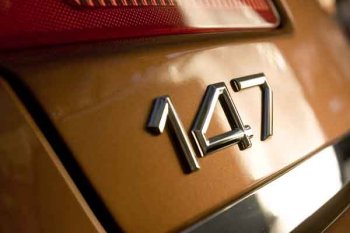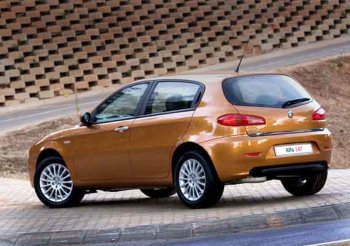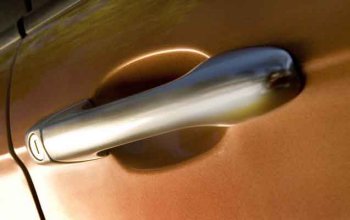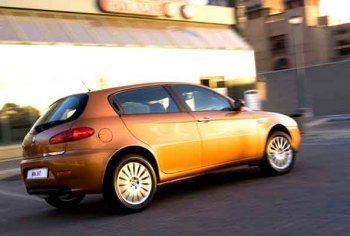|
The revised three- and
five-door Alfa Romeo 147 range has just gone on sale in
South Africa, featuring new Giugiaro styling, the addition
of the awesome 110 kW M-Jet diesel engine, uprated interiors
and revised chassis dynamics.
With recommended pricing
ranging from R183,000 to R219, 000, Alfa Romeo’s sporty
mid-size hatchback continues to offer a distinctive
alternative within the upper sub-C segment of the market.
Even more so than before, the new 147 model line-up will
suit a wide range of tastes and pockets. You can choose
from: three- and five-door versions, two petrol engines, two
diesel engines (the new MultiJet being the big news), and
Progression and Distinctive equipment options.
Launched in South Africa in
May 2001, the 147 has gone on to record over 360,000 sales
worldwide. Its special blend of Italian design flair and
advanced engineering, which translates into great handling
and sparkling performance, has won Alfa’s prestige compact
sports hatch no fewer than 27 awards, including European Car
of the Year in 2001. In the words of Giorgio Gorelli, Managing Director of Fiat Auto South Africa, the
New 147 is “proof that hatchback motoring can be exciting”.
“Unashamedly an Alfa Romeo,
the new 147 is the perfect marriage of style, practicality
and technology. The design revisions combined with the
under-the skin-technology in the form of the comfort
suspension and the addition of the award-winning MultiJet
diesel, take the New 147 to even greater iconic heights than
its predecessor,” Gorelli added.
The New 147 retains the
original’s well-proportioned, muscular lines, but the
bonnet, front wings and front bumper are all new to give a
cleaner, more dynamic front end. In particular, the
distinctive shield-type grille is now larger and positioned
lower and further forward. The most dramatic change,
however, has been applied to the headlights – they now sweep
back to
follow the lines of the V-shaped bonnet. Headlight units
have also been made more stylish thanks to their clear
covers and three projector style light elements. There’s now
a mesh covering to the lower air intakes and this adds extra
dynamic appeal. The overall result is a car with a far
keener sporting bias. The new-look front end adds to the
front overhang so that the New 147 is around 5cm longer than
its predecessor.
The new face is complemented by subtle design
changes at the rear, where the designers have reworked the
tailgate and extended the tail-lights in towards the centre
line of the car, to create a more triangular outline which
mirrors the lower edge of the rear tailgate glass. The
tailgate continues to be hinged 10 cm forward from the
trailing edge of the roof to make loading easier. The shape
is uncluttered by any handle, the tailgate being released
from inside the car or via the central locking remote, when
it is automatically released from the body to ensure it can
be conveniently raised.
The South African Alfa 147 range offers a choice of 13 colours,
five of them new: Radicofani Red, Pergusa Orange, Giannutri
Green, Dijon Blue and Navona Grey metallics.
One of the strengths of the Alfa Romeo 147
range has been the breadth of its engine choice. Petrol
engines in 88 kW 1.6 litre, and 110 kW 2.0 litre Twin Spark
guise were joined in 2004 by the 85 kW 1.9 litre JTD common
rail turbodiesel engine.The two Twin Spark engines feature 16 valves
and twin-overhead camshafts and offer great flexibility and
seamless power delivery, with plenty of torque even at low
engine speeds. Both the 88 kW 1.6 litre and 110 kW 2.0 litre
engines feature variable valve timing, while the 2.0 litre
also uses a variable geometry intake system for strong
performance allied to good fuel economy. 100 km/h is reached
from standstill in 10.6 and 9.3 seconds respectively, while
Combined cycle consumption figures are 8.2 l100 km
and 8.9 l100 km respectively. Twin counter-rotating
balancer shafts enhance further the refinement of the 2.0
litre mill.
Now entrenched in the 147 range, the 85 kW
JTD common rail diesel engine continues to offer spirited
performance but with a small appetite for fuel. Vital
statistics for this model are: 5.8 l100 km (combined
cycle), a top speed of 191 km/h and 0-100 km/h acceleration
in 9.9 seconds.
|



 |
|
With recommended pricing ranging from R183,000 to
R219, 000, Alfa Romeo’s sporty mid-size hatchback
continues to offer a distinct alternative within the
upper sub-C segment |
|
|



 |
|
The revised three- and five-door Alfa Romeo 147 range has just gone on sale in
South Africa, featuring new Giugiaro styling, the addition
of the awesome 110 kW M-Jet diesel engine, uprated
interiors, and revised chassis
dynamics |
|
|
But, the big news for 2005 is the debut of
the groundbreaking, 110 kW 1.9 litre JTD MultiJet engine in
the New 147. This engine, first seen in the GT, marks the
first appearance in South Africa of second-generation common
rail technology (bear in mind that Fiat pioneered
common-rail diesel technology). Its adoption of higher
injection pressures and multiple, but smaller injections,
delivers even greater performance and fuel efficiency,
together with reduced carbon dioxide emissions.
This engine, is a twin-overhead cam 16-valve
unit with a variable-geometry Garrett turbocharger,
delivering 110 kW at 4000 rpm, while the remarkable maximum
torque figure is 305 Nm at 2000 rpm. The unit produces a
smooth, reliable and quiet delivery of power, with
remarkably low fuel consumption allied to sparkling
performance and impressive flexibility.
The maximum torque figure is actually greater
than that generated by the 176 kW 3.2 litre petrol V6 of the
147 GTA, and the result is exceptional flexibility: 90% of
maximum torque is available between 1750 and 3250 rpm. The
0-100 km/h acceleration time drops from 9.9 seconds to
8.8seconds (in comparison to the 1.9 JTD UniJet), while the
combined cycle fuel consumption remains at a frugal 5.9
litres/100km.
MultiJet versus UniJet
MultiJet technology is based on the same
common rail principles as those employed in UniJet engines,
represented in the New 147 by the 85 kW 1.9 JTD unit. Within
a UniJet engine, a pilot injection raises temperature and
pressure inside the cylinder to improve combustion at the
time of the main power stroke. The MultiJet divides the main
injection into a number of smaller injections, affording a
fuller, more gradual combustion, while the amount of diesel
burnt at each stroke remains the same; smoother, quieter
combustion, reduced emissions and increased performance are
the result.
To facilitate multi-injection, the injectors
reduce the time lag between injections from 1500 to just 150
microseconds, and reduce the minimum quantity of fuel
injected from 2 to less than 1 cu mm. The control unit
constantly monitors engine rpm, torque required at any given
time by the driver, and coolant temperatures, and adjusts
the injection strategy accordingly.
Thus, when coolant temperature is less than
60 degrees and torque requirement low, two small and one
large injection are performed. As torque demand increases,
the number of injections drops to two; one small and one
large. Under conditions of high rpm and high torque demand,
only one injection is required whilst, with coolant
temperature at over 60 degrees, emissions are minimised with
one small, one large, then one small injection in the
sequence.
Hence, start-up times and exhaust smoke are
reduced, noise levels and vibration are lowered to ensure a
quieter drive and improved passenger comfort, fuel
consumption is reduced by a further 10% and emission control
reduction amounts to 50%. The MultiJet engine is mated to a six-speed
manual transmission, while other versions in the New 147
range are equipped with a five-speed manual ’box.Precision handling and great roadholding make
the Alfa 147 a real driver’s car, one that enhances everyday
driving satisfaction. Now, subtle changes to the damper
characteristics and suspension design have brought even
higher standards of ride comfort to complement its dynamic
ability. The proven and successful arrangement of double
wishbones at the front and MacPherson struts at the rear
continues to deliver exceptional lateral grip, swift
cornering, great efficiency and crisp steering response.
|
|
|
|
![]()
![]()